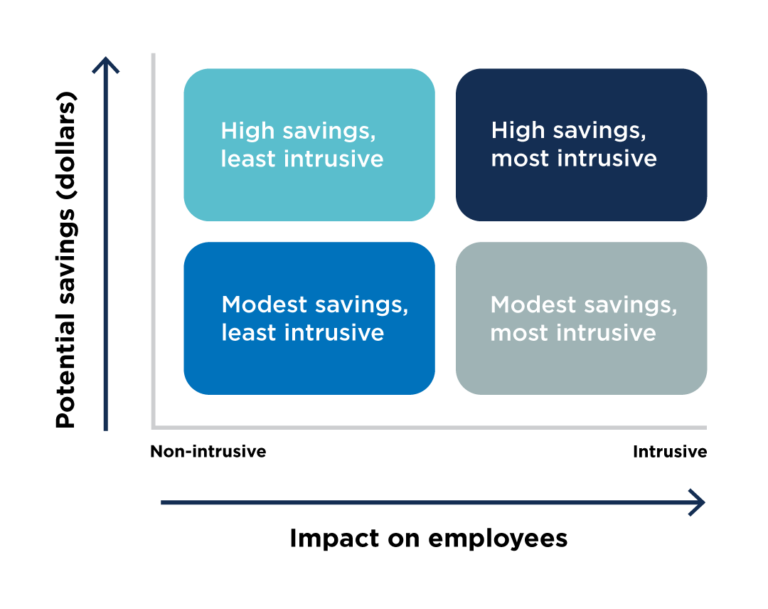With the market in flux, the great resignation (hopefully) behind us, and employees demanding more from their compensation and benefits plans, 2022 is already shaping up to be quite a year. According to a study conducted by the Society for Human Resources Management, health plan costs are returning to pre-pandemic levels. Benefits administrators and plan sponsors are seeing dramatic changes and emerging trends surrounding group benefit plans.
While some trends have been on the rise since the COVID-19 pandemic, such as virtual healthcare and pharmacy-by-mail, many organizations have also been forced to seek cost-cutting measures, revealing an opportunity to review group benefit plans on a deeper level.
Often, an organization’s first reaction is plan design cuts; however, cutting costs does not mean you also have to reduce member coverage. With the right benefits advisor, plan design changes can be one of the last considerations.
The continuum of cost containment
Changes to group benefit plans can be beneficial to all involved if done right; but they can also the wrong decision, in hindsight, if executed poorly. Group benefit plan changes can range from very effective and non-intrusive to a total miss. In the worst-case scenario, plan changes could have a significant negative impact on employee satisfaction.
Cost savings:
When it comes to cost containment, the best practice is obviously to aim for actions on the left side of the continuum: those that have the highest potential savings and are the least intrusive to employees.
Examples of cost containment strategies with high potential for success include:
- changing to funding models like administrative services only (ASO)
- introducing managed formularies for drugs
- completing a deep dive on your drug utilization
- negotiating administrative fees and long-term rate guarantees
- introducing mail-order pharmacies
On the right side of the continuum are strategies that have the potential to cause the greatest impact to employees. These strategies should be avoided where possible. While many of these options may have cost savings, they should only be considered as a last resort.
Some examples of riskier strategies for cost containment include:
- cutting life coverage from 2x to 1x
- overall benefit reductions
- introducing higher deductibles or copays to health and dental
- introducing a hard drug cap
- reducing scaling units and/or dental recalls
- removing semi-private or private hospital care
- reducing dental maximums
Six best practices for cost containment
1. Change funding models on health and dental
Many employers may not know that they can provide health and dental benefits in several different ways. A popular method of providing coverage is through fully insured health benefits plans. In this model, the employer pays a set rate for a given period – usually one year. No matter what employees claim in this period, premiums will not change. However, the rate premiums associated with fully insured plans tend to be high. As a result, these plans almost always result in a profit for the insurance companies. And if you experience a year that brings a claims increase, you can expect your rate premiums to increase more drastically the next year. Although in fairness, rate increases can occur for a number of reasons.
Many organizations have made the switch to an administrative services only (ASO) model, whereby they take responsibility for covering the cost of routine claims plus an administration fee. Organizations that go the ASO route can also purchase stop loss insurance to ensure that they will be covered for any high drug claims over a given amount (usually around $10,000 per year per employee). When moving to an ASO model, employers generally reduce costs on a permanent basis.
2. Market your pooled benefits
After moving health and dental benefits to an ASO funding model, your organization is free to focus on other non-intrusive cost savings measures. Consider, for example, taking life and long-term disability benefits to market. Canadian insurers will compete aggressively to earn new business and provide great rates. As a rule of thumb, you should set a target of 10 to 20 percent savings on pooled benefits like life and long-term disability insurance, as well as a long-term rate guarantee.
3. Risk management
It is important to understand the inherent risk that comes along the medical coverage plan you have selected for your organization. A large portion of the risk that effects plan sponsors comes along with unlimited drug coverage. While most plans have a cap on every other benefit (for example, a $500 annual cap on massages) many will not have a cap on drug coverage. Therefore, risk-averse employers should ensure they have insurance in place for high drug claims.
4. Introduce a wellness program
Did you know that preventable disabilities are the top cause of lost productivity for Canadian employers? Interestingly, “mental illness is associated with more lost work days than any other chronic condition, costing the Canadian economy $51 billion annually in lost productivity,” according to an article published in the Journal of Occupational & Environmental Medicine. When your employees are healthier and happier, absenteeism will drop – and so will health care costs. In fact, among employers who have implemented wellness programs, more than half saw a decrease in absenteeism and 66 per cent reported an increase in productivity.
5. Introduce preferred provider networks (PPN)
PPNs (preferred provider networks) are providers and retailers that are recommended by the employer because they provide either value-adds for employees, reduced costs associated for services, or both. Your insurance consultant should be able to provide you with a list of available PPNs through your current providers. Once you have identified the PPNs available to your employees, make sure to make the information easily accessible to employees for future reference.
6. Evaluate your group benefits consulting firm
Sometimes organizations fall into the well-intentioned trap of a partnership with a group benefits consulting firm who are not experts in the field. Your business and its employees deserve only the best.
If you’re looking to learn more about employee benefits best practices and cut health coverage costs while minimizing employee impact, an experienced group benefits consultant can help. People Corporation’s diverse team of 900+ experienced benefit consultants, employees and professionals has industry-specific expertise and can provide your business with uniquely valuable insight as they customize our innovative suite of solutions for your organization.
As a national provider, we partner with insurance carriers and suppliers to create unique and customized solutions, ensuring that our clients continually add value to their investment in their people.
Ready to cut health coverage costs in 2022 and beyond? It is possible. Get in touch with us today to learn more.




